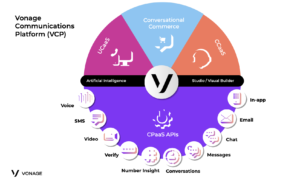 “Full stack solutions” have been a work in process since the early 2010s, when developers focused on holistic approaches to build applications that spanned all layers of a technology stack that included “front-end” user interfaces and “back-end” computing, database management and transaction processing. Their efforts made it possible for Web sites, mobile apps and messaging platforms to carry on conversations and complete transactions. Today, the “full stack” has to be both deeper and wider. Remote workers require the same capabilities as their counterparts who are returning to the office. Computer “servers” are just as likely to be in a cloud-based data center as they are to be in a company’s computer room. Most importantly, the data that informs all of the people and processes that make Conversational Commerce possible resides in data lakes or hubs that or distributed in repositories around the globe, in accordance with privacy or other regulatory strictures.
“Full stack solutions” have been a work in process since the early 2010s, when developers focused on holistic approaches to build applications that spanned all layers of a technology stack that included “front-end” user interfaces and “back-end” computing, database management and transaction processing. Their efforts made it possible for Web sites, mobile apps and messaging platforms to carry on conversations and complete transactions. Today, the “full stack” has to be both deeper and wider. Remote workers require the same capabilities as their counterparts who are returning to the office. Computer “servers” are just as likely to be in a cloud-based data center as they are to be in a company’s computer room. Most importantly, the data that informs all of the people and processes that make Conversational Commerce possible resides in data lakes or hubs that or distributed in repositories around the globe, in accordance with privacy or other regulatory strictures.
Today’s “New Full Stack” is both deeper and wider than previous renditions and solution providers have expanded their product offerings accordingly. A case in point is Vonage which is just about to complete its first year as a subsidiary of wireless communications infrastructure giant, Ericsson. The company has organized a full-stack solution set of its own that has four major components:
- Communications APIs – to support customer engagement engage cross messaging, voice and video.
- Unified Communications – benefitting from a stable, global network platform that is enhanced through the relationship that Ericsson has with global carriers.
- Contact Centers – that benefit from the global network and APIs, as well as tools for integrating Artificial Intelligence and transactional resources
- Conversational Commerce – enabling companies to engage and re-engage with customers through messaging platforms
Opus Research chronicled the company history in this post from November 2018 when we said that the combination of Vonage, NewVoiceMedia and Nexmo “defined the full solution stack for Conversational Commerce”. Kudos to top management for not stopping at this milestone. It has since acquired Over.ai and Jumper.ai to add Conversational AI and messaging platform-based Conversational Commerce, respectively.
Successful integration of CPaaS, UCaaS, CCaaS and Conversational AI into its solutions set Vonage apart in Opus Research’s Conversational Cloud Intelliview 2023.
Ericsson Adds Mobility and Deeper Integrations into Carrier Networks
As a subsidiary of Ericsson, Vonage is adding another layer to that is foundational to its solution stack. It starts with large-scale long-term investment in research & development into advanced network services, establishing leadership in 5G wireless infrastructure. But it also benefits from long-standing, deep relationships with leading carriers around the globe.
Today, with attention focusing on Generative AI and Large Language Models, the quality of underlying communications networks is an afterthought. That will not be true for long. Vonage (cum Ericsson) supports seamless mobility services made possible by application integration through 5G APIs. The combined company is fulfilling the value proposition we outlined prior to the Ericsson acquisition, when it acquired Jumper.ai. As we noted,”it will beef up each brand’s ability to start conversations with an outbound text (permissioned of course) or alert. More importantly, it makes the check out or “point-of-sale” an integral part or (more accurately) culmination of each conversation.”
Categories: Conversational Intelligence, Intelligent Assistants, Articles

 2025 Conversational AI Intelliview: Decision-Makers Guide to Self-Service & Enterprise Intelligent Assistants
2025 Conversational AI Intelliview: Decision-Makers Guide to Self-Service & Enterprise Intelligent Assistants  Talk to the Web: How NLWeb Opens Conversational Access to Site Content
Talk to the Web: How NLWeb Opens Conversational Access to Site Content  Voice AI Agents Redefine CX: Trends, ROI, and Strategies for 2025
Voice AI Agents Redefine CX: Trends, ROI, and Strategies for 2025  Why Voice AI Is Foundational for Enterprise Innovation (Webinar)
Why Voice AI Is Foundational for Enterprise Innovation (Webinar)